Disability inclusion in camp settings extends beyond hiring specialized staff or assigning one person to focus on accessibility.
True inclusion means fostering a culture where every team member — from frontline workers to leadership — is actively committed to creating an environment where all campers, including those with disabilities, feel a sense of belonging.
When every role embraces this mission, inclusion becomes a natural part of your organization’s fabric. Here’s how to overcome barriers, redefine roles, and empower all staff to build a culture of inclusion.
Understanding the Challenges of Inclusion
To build a truly inclusive team, it’s essential to recognize some of the key obstacles that can slow progress or inadvertently alienate employees:
- Lack of Clear Expectations: Employees may not realize how their roles relate to inclusion if expectations aren't clearly outlined.
- Limited Training and Support: Even with good intentions, staff may lack the confidence or skills to implement inclusive practices.
- Over-reliance on Specialists: While inclusion specialists are valuable resources, expecting them alone to handle all inclusion efforts can hinder true organizational commitment.
Practical Strategies to Foster a Culture of Inclusion
To address these challenges, focus on strategies that bring all staff on board, clarify roles, and encourage shared responsibility.
1. Set Clear Expectations with Inclusive Job Descriptions
Language matters when outlining job responsibilities. Every role, from frontline counselors to site supervisors, should include clear expectations around inclusion. Consider weaving in specific responsibilities related to accessibility, empathy, and support for individuals with disabilities. This practice signals that inclusion isn’t just a value but a core responsibility for all.
Consider including:
- Proactively identify and remove barriers to participation by adapting activities, spaces, and communication methods to ensure all campers can engage fully.
- Demonstrate empathy and positive reinforcement by using strengths-based language and providing individualized support to help all participants feel valued and included.
- Attend and engage in disability inclusion training as part of required professional development.
- Implement inclusive strategies learned during training, including activity adaptations and communication techniques.
- Participate in an Inclusion Advisory Team or feedback group to assess and improve accessibility and belonging within the camp community.
2. Equip and Empower Staff with Training
Building an inclusive camp culture requires training for all staff, not just specialists. Practical, hands-on learning in communication, using inclusive strategies, and adapting activities empowers employees at all levels to confidently make inclusion part of their daily work.
Examples include:
- Incorporate Inclusive Tools: Train staff on using visual schedules, sensory supports, and clearly defined expectations to reduce anxiety and increase success.
- Apply the T.R.E.E. Method for Adaptations: Teach staff to evaluate and modify activities based on:
- Teaching style: Adjust instructions for clarity and accessibility.
- Rules: Simplify or modify rules to promote success.
- Equipment: Use adaptive equipment or alternative materials.
- Environment: Modify spaces for accessibility and sensory considerations.
- Teaching style: Adjust instructions for clarity and accessibility.
- Lead Hands-On Inclusion Workshops: Facilitate staff training with interactive examples of adaptations and provide a quick reference guide summarizing key strategies for continued learning.
- Create a Culture of Sharing: Establish regular check-ins or forums where staff can share inclusion successes, strategies, and challenges, making inclusive practice part of the camp’s core culture.
- Develop an "Inclusion Resource Binder”: Include strategies, activity modifications, and success stories, encouraging staff to contribute.
When staff feel equipped and supported, inclusion becomes a natural part of the camp.
3. Reframe Specialist Roles as Mentors
Rather than having inclusion specialists handle all disability-related needs, encourage them to serve as mentors. In this mentorship model, specialists support and teach other staff members, helping them feel capable of implementing inclusive practices independently. This approach not only fosters a sense of shared responsibility but also amplifies the reach and impact of inclusion efforts across the organization
Mentorship in Action: Empowering Inclusive Leadership
Maggie, an inclusion specialist with expertise in supporting children with disabilities and neurodivergence, used to be called upon by camp counselor Jessie to “take care of” situations when a camper was struggling. In those moments, Maggie would often remove the camper from the group, provide support, and then reintegrate them when ready.
Since shifting to an organizational commitment approach where all staff receive training and tools for inclusive practices, mentorship now looks different — and far more empowering.
Recently, Jessie called Maggie over during a challenging moment with a camper. Instead of stepping in directly, Maggie invited Jessie to collaborate, suggesting they review the Inclusion Binder together to identify strategies that had been tried and explore additional options. Upon reflection, Jessie realized that visual tools hadn’t been consistently used with this camper or the group.
Maggie then modeled how to use visual tools effectively in the group setting while Jessie observed. The next day, Jessie independently implemented the strategies with Maggie present for guidance if needed. By day three, Maggie checked in with Jessie, who reported noticeable improvements with the camper’s participation. Jessie now felt more confident and equipped to independently apply inclusive strategies, transforming from seeking outside help to leading inclusive practices firsthand.
The result? A more empowered staff, a camper who felt supported within the group, and a stronger culture of belonging for all.
Inclusion in Performance Evaluations
Performance evaluations are another opportunity to reinforce the importance of disability inclusion. Here’s how to incorporate an inclusion lens into evaluations and hold staff accountable for inclusive behavior:
- Add Specific Inclusion Metrics: Evaluations should include metrics tied to inclusion. For example, assess how well a staff member has supported diverse needs, implemented modifications, or adapted their communication style to be more inclusive.
- Highlight Collaboration and Empathy: Use evaluation criteria that recognize soft skills like empathy, active listening, and teamwork, all of which contribute to an inclusive environment.
Building Belonging Beyond Inclusion
Inclusion is more than just physical access or adaptive support. Belonging takes inclusion a step further by fostering a welcoming environment where all feel valued, respected, part of the camp community, and can make a friend. Here are tips to cultivate belonging:
- Recognize and Celebrate Differences: Highlight the unique talents and interests each staff member and camper brings to your camp. This approach has a strength, not deficit focus and signals that everyone has something valuable to offer.
- Create Spaces for Connection: Foster social interactions by ensuring activities are accessible and welcoming to all. Encourage shared meals, collaborative projects, or group activities where everyone has a meaningful role and can engage together.
Call to Action: Bring These Strategies to Life
Building an inclusive camp culture is a team effort. Engage every staff member in creating a welcoming environment where all belong. By working together, your camp can thrive as a supportive, inclusive space for everyone to belong!
This blog was written on behalf of ACA's Project Real Job, whose goal is to support camps in their efforts to recruit, hire, and retain staff.
Lisa Drennan is the founder of MERGE Diverse Abilities Inclusion Consulting, providing staff training and expert consultation to recreation, camp, sport and community organizations on how to be inclusive of people with diverse abilities. She is the primary author of Building Friendships between people with and people without disabilities, made possible by The Arc Massachusetts.
The views and opinions expressed by contributors are their own and do not necessarily reflect the views of the American Camp Association or ACA employees.




